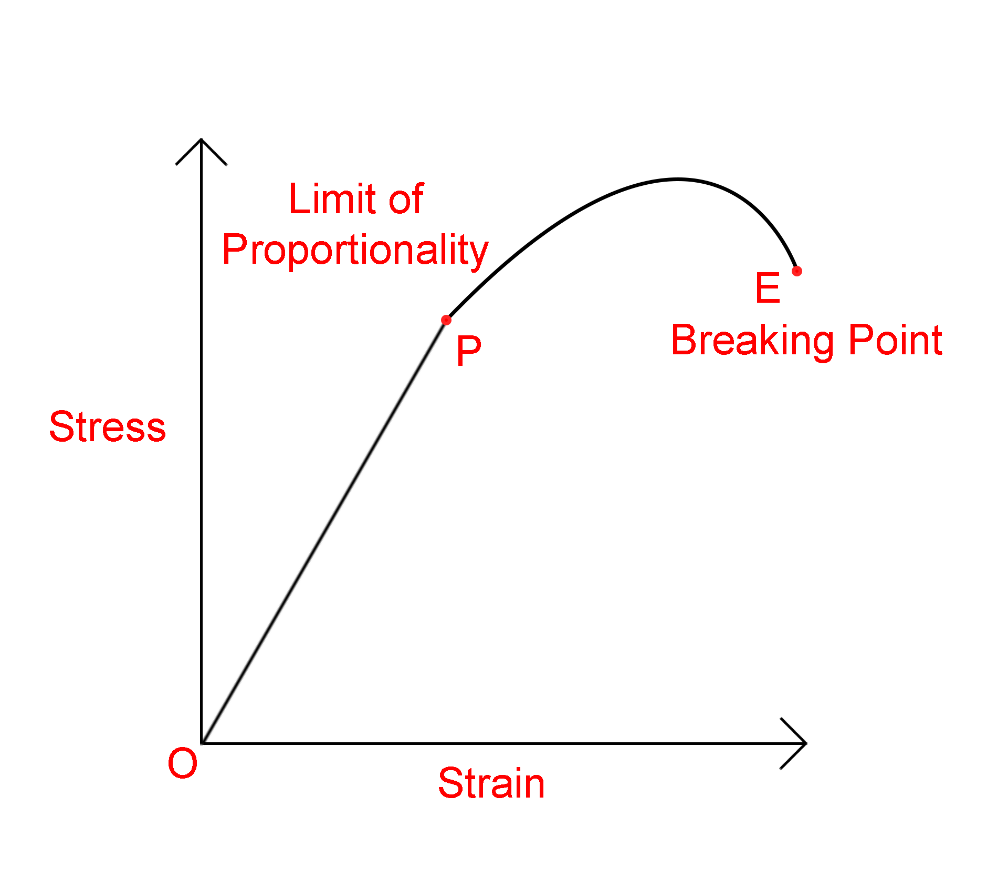
The breaking stress of a wire depends upon
A. The length of the wire
B. The radius of the wire
C. The material of the wire
D. The shape of the cross-section
Answer
571.2k+ views
Hint: We know that the equation for the relation of stress and strain is $\dfrac{{Stress}}{{Strain}} = \gamma $ . This means that the stress on an object depends on $\gamma $ . Now $\gamma $ as we already know depends upon the material that makes up the wire.
Complete answer:
Before starting the actual solution, it would be good to discuss stress, stress, and their relationship.
Stress – Stress is the force applied per unit area on a material.
Strain – Strain is the change in the dimensions of material when it is under stress.
The relation of stress-strain is given below
$\dfrac{{Stress}}{{Strain}} = \gamma $
Here, $\gamma = $ The proportionality of linear expansion
The stress-strain graph is shown below

In this graph, you can see the point E which is called the breaking point where the object can longer bear the stress and just breaks into two. At this point even if we reduce the stress the strain still increases.
By the stress-strain equation, i.e. $\dfrac{{Stress}}{{Strain}} = \gamma $ , we can see that the strain of a body does not depend on the length of the wire, the shape of the cross-section of the wire, and the radius of the wire.
But stress does depend on $\gamma $ . Now $\gamma $ depends on the material of the wire, so the breaking stress also depends on the material of the wire.
In simple words, it means that two objects made of different material will have different breaking stress (the limit of strain the body can bear)
So, the correct answer is “Option C”.
Note:
The concept of breaking stress that we discussed in the solution above is of great importance to us. Every object that we use whether it be lifts, bridges, mobiles phones, etc. are designed in such a manner that the stress on the object does not exceed the safe limit in normal day to day usage.
Complete answer:
Before starting the actual solution, it would be good to discuss stress, stress, and their relationship.
Stress – Stress is the force applied per unit area on a material.
Strain – Strain is the change in the dimensions of material when it is under stress.
The relation of stress-strain is given below
$\dfrac{{Stress}}{{Strain}} = \gamma $
Here, $\gamma = $ The proportionality of linear expansion
The stress-strain graph is shown below

In this graph, you can see the point E which is called the breaking point where the object can longer bear the stress and just breaks into two. At this point even if we reduce the stress the strain still increases.
By the stress-strain equation, i.e. $\dfrac{{Stress}}{{Strain}} = \gamma $ , we can see that the strain of a body does not depend on the length of the wire, the shape of the cross-section of the wire, and the radius of the wire.
But stress does depend on $\gamma $ . Now $\gamma $ depends on the material of the wire, so the breaking stress also depends on the material of the wire.
In simple words, it means that two objects made of different material will have different breaking stress (the limit of strain the body can bear)
So, the correct answer is “Option C”.
Note:
The concept of breaking stress that we discussed in the solution above is of great importance to us. Every object that we use whether it be lifts, bridges, mobiles phones, etc. are designed in such a manner that the stress on the object does not exceed the safe limit in normal day to day usage.
Recently Updated Pages
Why are manures considered better than fertilizers class 11 biology CBSE

Find the coordinates of the midpoint of the line segment class 11 maths CBSE

Distinguish between static friction limiting friction class 11 physics CBSE

The Chairman of the constituent Assembly was A Jawaharlal class 11 social science CBSE

The first National Commission on Labour NCL submitted class 11 social science CBSE

Number of all subshell of n + l 7 is A 4 B 5 C 6 D class 11 chemistry CBSE

Trending doubts
Differentiate between an exothermic and an endothermic class 11 chemistry CBSE

1 Quintal is equal to a 110 kg b 10 kg c 100kg d 1000 class 11 physics CBSE

Explain zero factorial class 11 maths CBSE

What is boron A Nonmetal B Metal C Metalloid D All class 11 chemistry CBSE

Bond order ofO2 O2+ O2 and O22 is in order A O2 langle class 11 chemistry CBSE

Distinguish between verbal and nonverbal communica class 11 english CBSE




